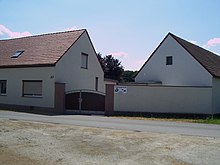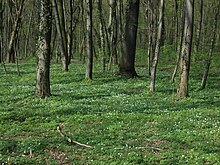Niemtsch
|
Niemtsch
Nimješk City of Senftenberg
Coordinates: 51 ° 29 ′ 36 ″ N , 13 ° 58 ′ 51 ″ E
|
|
|---|---|
| Height : | 100 m |
| Residents : | 355 (Jan 1, 2019) |
| Incorporation : | December 31, 2001 |
| Postal code : | 01968 |
| Area code : | 03573 |
Niemtsch , Nimješk in Lower Sorbian , is a district of the Brandenburg district town Senftenberg in the Oberspreewald-Lausitz district . It is located in northern Upper Lusatia directly on Lake Senftenberg and the Black Elster .
history
Interpretation and development of the place name
Niemtsch was mentioned in 1496 as Nemjesk , derived from the Sorbian term for "German" ( Němc or Nimc ). However, this name belies the fact that the place was founded by Sorbian people. In 1733 the name had already developed into Niemitzsch .
timeline
Niemtsch was founded as a Sorbian round square village in a forest and water-rich area . The place had a vineyard with vineyard ponds. In 1733 the governor of Senftenberg Friedrich von Götz auf Hohenbocka was enfeoffed with Niemtsch.
In 1938, lignite mining began in the Niemtsch opencast mine. Shortly before the end of the Second World War in 1945, the opencast mine was deliberately flooded. On December 1, 1945, coal mining could be started again. The last coal train left the mine on May 15, 1966. The mine was then flooded and converted into the Senftenberger See .
On January 1, 1974, Niemtsch was incorporated into the neighboring town of Brieske . On May 6, 1990, however, Niemtsch was hived off again. At the end of December 30, 2001, both places were incorporated into Senftenberg. From 1992 to the end of 2001 Niemtsch was part of the Am Senftenberger See office .
Since September 9, 2016, Niemtsch has been part of the Senftenberg urban area that has been awarded the title of state-recognized resort .
Population development
| Population development in Niemtsch from 1875 to 2000 | |||||||||||
|---|---|---|---|---|---|---|---|---|---|---|---|
| year | Residents | year | Residents | year | Residents | year | Residents | year | Residents | year | Residents |
| 1875 | 200 | 1933 | 362 | 1964 | 303 | 1989 | - | 1993 | 238 | 1997 | 303 |
| 1890 | 250 | 1939 | 370 | 1971 | 278 | 1990 | 201 | 1994 | 265 | 1998 | 326 |
| 1910 | 300 | 1946 | 389 | 1981 | - | 1991 | 210 | 1995 | 291 | 1999 | 328 |
| 1925 | 368 | 1950 | 364 | 1985 | - | 1992 | 222 | 1996 | 305 | 2000 | 342 |
According to statistics from Arnošt Muka , Niemtsch had a total of 320 inhabitants in 1885, including 210 Sorbs (66%) and 110 Germans.
Sightseeing and tourism
In Niemtsch there is a landing stage for the motor ship Santa Barbara , which offers tours on Lake Senftenberg . There is a campsite not far from the pier . The Niemtscher Mühle restaurant, located directly on Lake Senftenberg, is a popular destination for cyclists, especially in summer.
On the occasion of the 500th anniversary of Niemtsch, the private mining museum Niemtsch was opened on July 1st, 1996 . It was headed by Dieter Müller, who collected contemporary mining objects in his 45 years of activity in lignite mining. The collection includes around 1250 briquettes , mainly jewelry, special and decorative briquettes . These include valuable pieces and unique specimens, for example the first briquette from the “Henkel” company from 1871. The collection also contains miner's lamps, climbing chaff and other miner's utensils as well as graphic representations of mining production processes. In the meantime the mining museum has been closed. As soon as the city of Senftenberg has found a suitable location, the collection will be exhibited there on loan.
On the village green there is a war memorial for the fallen of the First World War with an additional plaque for the fallen of the Second World War .
Niemtscher Park and manor
In Niemtsch there was a manor with a castle park. The associated manor house, stables and outbuildings were demolished at the end of 2011. The manor house was built from 1820 to 1840 in the classical style . The von Götz family was the feudal lord.
The 17 hectare Niemtscher Park has an old population of deciduous trees. A nature trail has been set up in the park. The former castle park probably served as forest pasture for the stately animals. Today the park is a small remnant of the dense and species-rich primeval floodplain forests that once stretched along the Black Elster. In spring the forest floor is covered by a carpet of anemones and shines in its white color. The park is a habitat for numerous plants and animals. The park and manor house are among the architectural monuments in Senftenberg .
literature
- Isolde Rösler, Heinz Noack: Senftenberger See . Historical hikes through Buchwalde , Kleinkoschen , Großkoschen , Hosena , Peickwitz , Niemtsch, Brieske , Colony Marga . Ed .: Senftenberg District Museum . Geiger, Horb am Neckar 1993, ISBN 3-89264-872-7 .
Individual evidence
- ↑ Municipalities 1994 and their changes since January 1, 1948 in the new federal states , Metzler-Poeschel publishing house, Stuttgart, 1995, ISBN 3-8246-0321-7 , publisher: Federal Statistical Office
- ↑ StBA: Changes in the municipalities in Germany, see 2001
- ↑ Press release from the Brandenburg Ministry for Economic Affairs and Energy from September 9, 2016
- ↑ Historical municipality register of the state of Brandenburg 1875 to 2005. (PDF; 331 kB) District Oberspreewald-Lausitz. State Office for Data Processing and Statistics State of Brandenburg, December 2006, accessed on September 10, 2015 .
- ↑ Ernst Tschernik : The development of the Sorbian population . Akademie-Verlag, Berlin 1954.
- ↑ Niemtsch Mining Museum. (No longer available online.) Archived from the original on August 1, 2015 ; accessed on September 10, 2015 . Info: The archive link was inserted automatically and has not yet been checked. Please check the original and archive link according to the instructions and then remove this notice.
- ↑ Niemtsch Castle is a pile of rubble. In: Lausitzer Rundschau , Senftenberg regional edition. October 26, 2011, accessed September 10, 2015 .
- ↑ Information board in Niemtsch in front of the manor house





